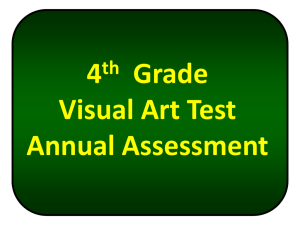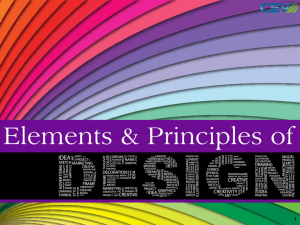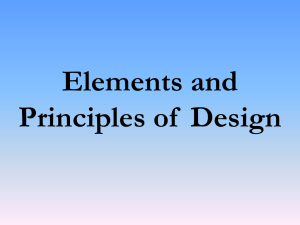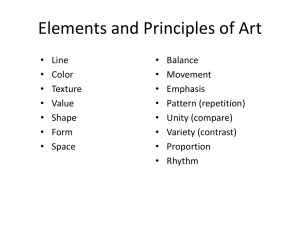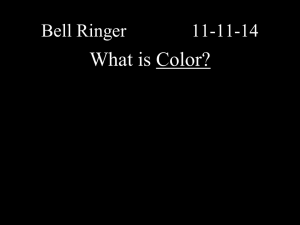Chapter 2 Lecture – Principles I
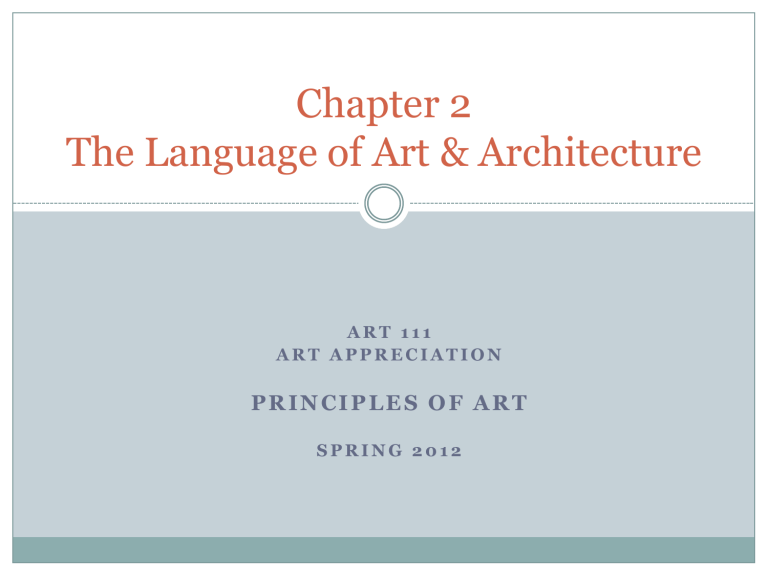
Chapter 2
The Language of Art & Architecture
A R T 1 1 1
A R T A P P R E C I A T I O N
P R I N C I P L E S O F A R T
S P R I N G 2 0 1 2
Color
All of the colors are derived from the three primary colors (red, blue, and yellow) and black and white. Color has three properties: hue, value, and intensity.
Ojibwe beadwork
Hue
Name and properties of a color
Value
Relative Light and
Darkness
Local Value
(Rendering)
Created Value
(Modeling)
Color Systems
Additive Subtractive red + green + blue = white magenta + yellow + cyan = black
Learn the Color Wheel
Primary Color
Secondary Colors
Tertiary Colors
Complementary Contrasts
Opposite colors are complementary
Analogous Colors
Are beside each other on the color wheel
Tints & Shades
Visualize the color wheel created in different ways
Do colors have personality ?
Warm & Cool
PRINCIPLES OF ART
Composition - the arrangement of formal elements in a work of art.
Pattern/Repetition
Balance
Rhythm/Movement
Proportion & Scale
Emphasis
Unity/Harmony
Variety/Contrast
Pattern & Repetition
Pattern refers to the repetition or reoccurrence of a design element, exact or varied, which establishes a visual beat.
Blanket
Tlingit people, Chilkat style. Mountain goat wool and cedar bark, 31" × 71", excluding fringe.
Functions
Pattern may function as decoration.
Pattern helps organize ideas into visual diagrams that make relationships clear.
Rhythm & Movement
Rhythm or Movement refers to the suggestion of motion through the use of various elements
Time and Motion, particularly in photography, film, kinetic sculpture and performance art are directly related to this principle.
Nude Descending a Staircase
(No. 2) , Marcel Duchamp1912.
Oil on canvas, 57 7/8" × 35 1/8"
Kinetic Art Examples
Film:
Race Horse First Film Ever 1878 Eadweard Muybridge
.
Performance:
The Lovers, 2005, Bill Viola
Sculpture
Theo Jansen's Object which I made with paper
Balance
Balance - placing elements so that their visual weights seem evenly distributed.
Types of balance:
Symmetrical: exact or even balance of objects or activity in a composition (mirror images)
Asymmetrical: careful distribution of uneven elements. counterbalanced with contrasts such as dull and bright colors, dark with light values, geometric with organic shapes, active and inactive areas
Radial: objects or activity rotating around a center point
Symmetrical Balance
Cow’s Skull: Red, White, and Blue,
1931, Georgia O’Keefe, oil on canvas,
39 7/8 x 35 7/8 inches.
A tile from The Wazir Khan Mosque in Lahore, Pakistan , 1634-1635 A.D
Asymmetrical Balance
Relativity , 1953, M.C. Escher, lithograph,
10.9x11.5 inches
Composition with Yellow, Blue, and
Red , 1937 –42, Piet Mondrian, oil on canvas, 72.5 x 69 cm
Radial Symmetry
Interior of the Rose Stain Glass window at
Strasbourg Cathedral.
Strasbourg Cathedral , 1015-1439,
Strasbourg, France, architecture, 142 m
(466 ft)
World’s tallest building from 1647 to 1874
Symmetry in Architecture
Video
Taj Mahal, 1632 –1653, Agra, India, 171 m (561 ft)

